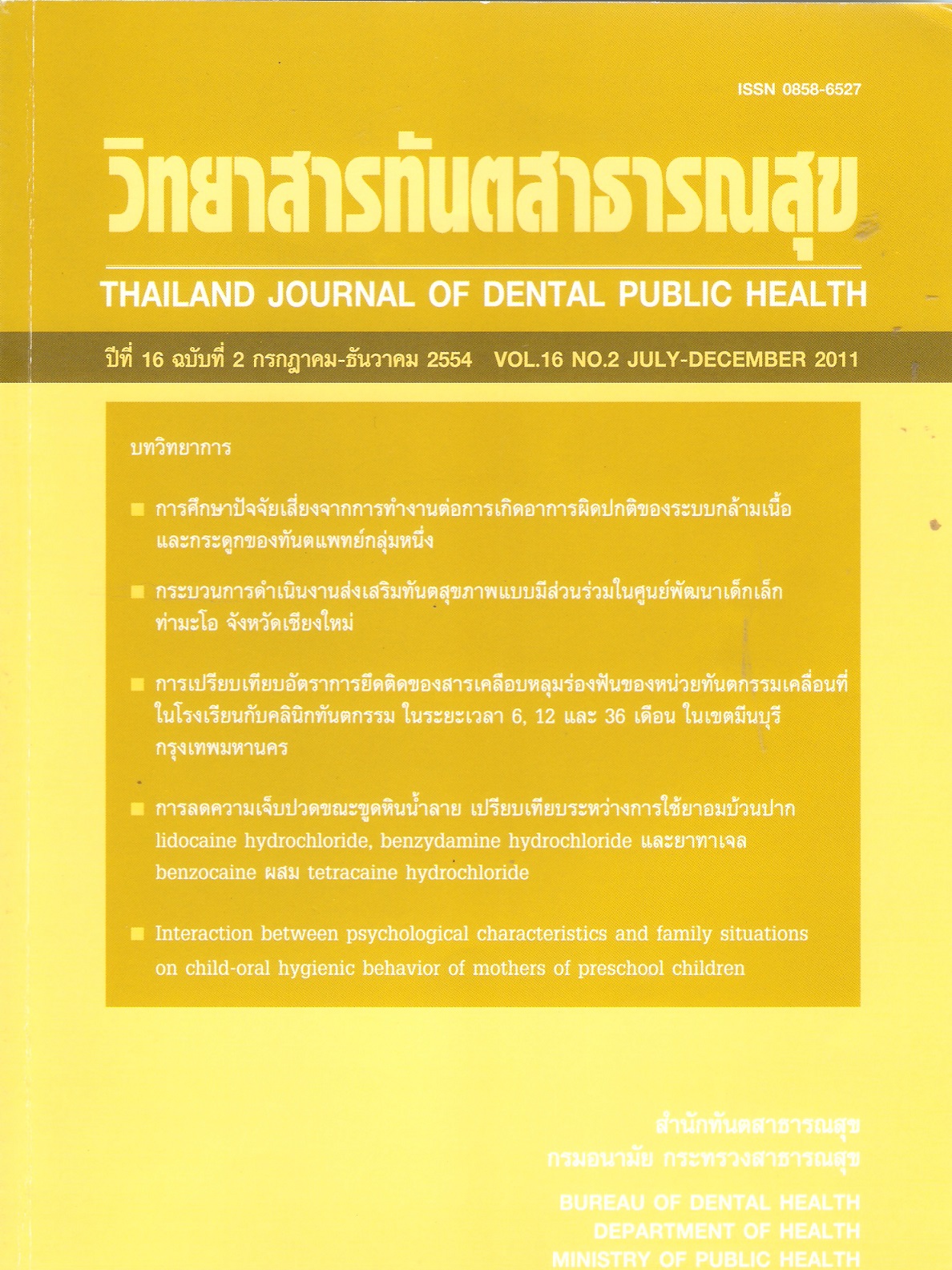Interaction between psychological characteristics and family situations on child-oral hygienic behavior of mothers of preschool children
Main Article Content
Abstract
Major objective of this study was to find interaction between psychological characteristics and family situations on child - oral hygienic behavior of mothers of preschool children. This was a correlational-comparative study based on the interactionism model of behavior analysis. In this study 843 mothers were asked to respond to questionnaires and 843 (5 years old) children were examined the oral health status. T- test, Three-way, two-way and also one-way Analysis of Variance were performed on the total sample as well as the subsamples identified by biosocial and background characteristics of mothers. Furthermore, the Stepwise Multiple Regression Analyses were carried out as well. Two important findings were: Firstly, mothers whose children had poorer dental health were 1) Mothers who had low income and did not have occupation. 2) Mothers who had lower child-oral-hygienic behavior. Secondly, the health behavior model (K-A-P) was necessary but inadequate for dental health care behavior of these mothers. Belief in internal locus of control concerning health should be added. Therefore, it can be recommended that low income, non- working and less knowledgeable mothers should be trained and an evaluation study should be carried out.
Downloads
Article Details
References
2. Bhanthumnavin D. Theory of moral behavior : Research and individual development : Advanced textbook in psychology and behavioral science. 2nd edition. National Institute of Development Administration. Bangkok, Thailand. 1995.
3. Bhanthumnavin D. A new psychological theory for the behavioral development of Thai youth. In the proceeding of 6th Asian Workshop on Child and Adolescent Development (pp. 430-432). Behavioral Science Research Institute,Srinakharinwirot University,Bangkok, Thailand. 1990.
4. Bhanthumnavin D. Theory of morality for Thai people : Research and applications. Special Monograph for the 33rd anniversary of Behavioral Science Research Institute. Srinakharinwirot University. Bangkok, Thailand. 1988.
5. Bhanthumnavin D. Review of studies on favorable psychological traits in Thai youth and adults. Thai Journal of Educational Research. 1980 ; 10(2), 29-47.
6. Dental Health Division, Department of Health. The Report of The Sixth National Oral Health Survey. 1st edition, Bangkok, Thailand. 2008.
7. Lill-Kari Wendt., Anna-Lena Hallonsten., Goran Koch and Dowen Birkhed. Oral hygiene in relation to caries development and immigrant status in infants and toddlers. Scandinavian Journal of Dental Research. 1994 ; 102, 269-273.
8. Paunio P., Rautava P., Sillanpaa M. and Kaleva O. Dental health habits of 3 year-old Finnish children, 1993 ; volume 21, issue 1: 4-7.
9. Petersen P.E. Sociobehavioural risk factors the in dental caries: international perspectives. Community Dentistry and Oral Epidemiology. 2005; 33 : 274-279.
10. Persson L.A., Holm A.K., Arvidsso S. & Samuelson G. Infant feeding and dental caries - a longitudinal of Swedish children. Swedish Dental Journal. 1985; 9, 201-206.
11. Pine C.M., Adair P.M., Petersen P.E., Douglass Ch., Burnside G., Nicoll A. et al. Developing explanatory models of health inequalities in childhood dental caries. Community Dental Health. 2004 ; 21: 86-95.
12. Schroder U. & Granath L. Dietary habits caries in 3-year-old children, Community Dentistry and Oral Epidemiology. 1983; 11, 308-311.


